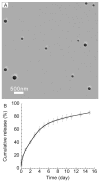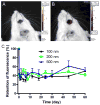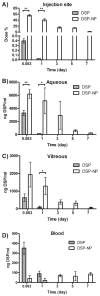Corticosteroid-loaded biodegradable nanoparticles for prevention of corneal allograft rejection in rats
- PMID: 25576786
- PMCID: PMC6037178
- DOI: 10.1016/j.jconrel.2015.01.009
Corticosteroid-loaded biodegradable nanoparticles for prevention of corneal allograft rejection in rats
Abstract
Immunologic graft rejection is one of the main causes of short and long-term graft failure in corneal transplantation. Steroids are the most commonly used immunosuppressive agents for postoperative management and prevention of corneal graft rejection. However, steroids delivered in eye drops are rapidly cleared from the surface of the eye, so the required frequency of dosing for corneal graft rejection management can be as high as once every 2h. Additionally, these eye drops are often prescribed for daily use for 1 year or longer, which can result in poor patient compliance and steroid-related side effects. Here, we report a biodegradable nanoparticle system composed of Generally Regarded as Safe (GRAS) materials that can provide sustained release of corticosteroids to prevent corneal graft rejection following subconjunctival injection provided initially during transplant surgery. Poly(lactic-co-glycolic acid) (PLGA) nanoparticles containing dexamethasone sodium phosphate (DSP) exhibited a size of 200 nm, 8 wt.% drug loading, and sustained drug release over 15 days in vitro under sink conditions. DSP-loaded nanoparticles provided sustained ocular drug levels for at least 7 days after subconjunctival administration in rats, and prevented corneal allograft rejection over the entire 9-week study when administered weekly. In contrast, control treatment groups that received weekly injections of either placebo nanoparticles, saline, or DSP in solution demonstrated corneal graft rejection accompanied by severe corneal edema, neovascularization and opacity that occurred in ≤ 4 weeks. Local controlled release of corticosteroids may reduce the rate of corneal graft rejection, perhaps especially in the days immediately following surgery when risk of rejection is highest and when typical steroid eye drop administration requirements are particularly onerous.
Keywords: Corneal rejection; Corneal transplantation; Dexamethasone; Drug delivery; PLGA.
Copyright © 2015 Elsevier B.V. All rights reserved.
Figures









References
-
- Chong EM, Dana MR. Graft failure IV. Immunologic mechanisms of corneal transplant rejection. Int Ophthalmol. 2008;28:209–222. - PubMed
-
- Tan DTH, Dart JKG, Holland EJ, Kinoshita S. Corneal transplantation. Lancet. 2012;379:1749–1761. - PubMed
-
- Al-Swailem SA. Graft failure: II. Ocular surface complications. Int Ophthalmol. 2008;28:175–189. - PubMed
-
- Tabbara KF. Pharmacologic strategies in the prevention and treatment of corneal transplant rejection. Int Ophthalmol. 2008;28:223–232. - PubMed
-
- Randleman JB, Stulting RD. Prevention and treatment of corneal graft rejection: current practice patterns (2004) Cornea. 2006;25:286–290. - PubMed
Publication types
MeSH terms
Substances
Grants and funding
LinkOut - more resources
Full Text Sources
Other Literature Sources
Medical
Miscellaneous

